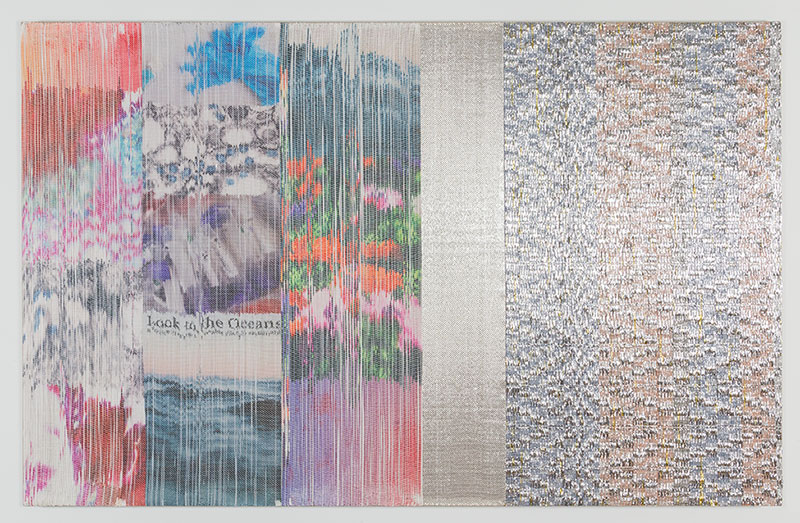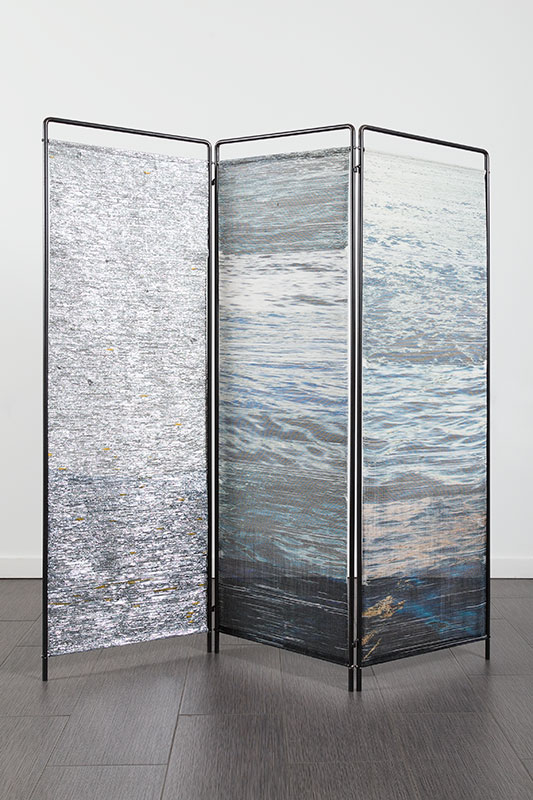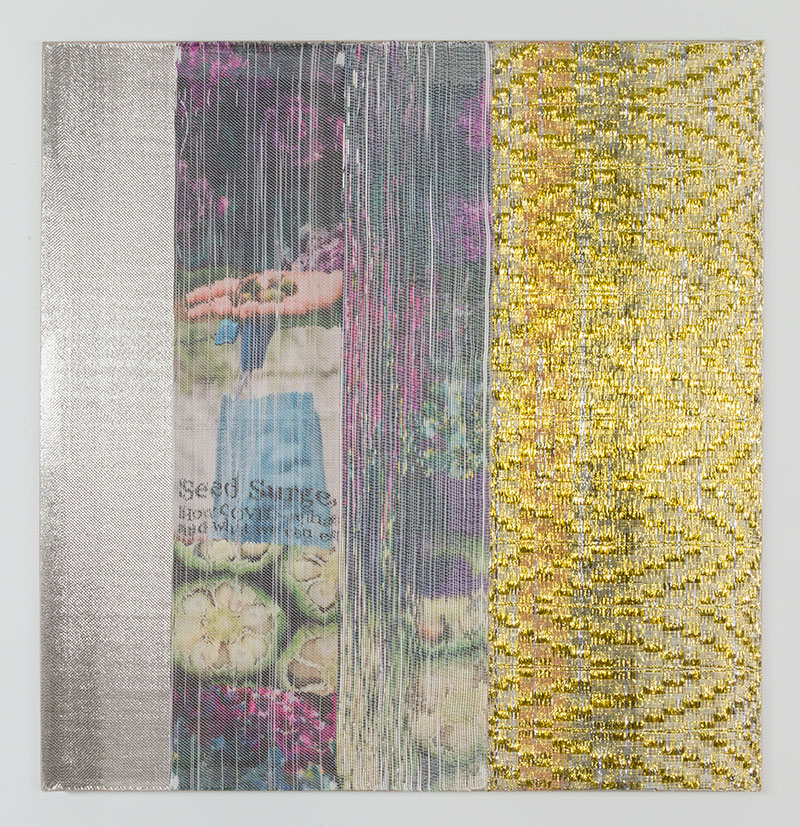Margo Wolowiec: An Artist Translates Signals of Our Times


BY ALISON REILLY
Margo Wolowiec, who lives in Detroit and studied at the School of the Art Institute of Chicago (SAIC), uses a complex process involving digital image manipulation, transfer paper, and a floor loom to create arresting textiles that, from a distance, read as paintings. Inspired by current political and social conditions, Wolowiec considers how existential threats like climate change are expressed through our increasingly digital lives. This fall, her work will be featured in an exhibition showcasing artists from the Midwest at the Contemporary Arts Center in Cincinnati.
CGN: How have the past 18 months since the pandemic started been for you (as an artist)? How has your art practice changed during this period?
Margo Wolowiec: The pandemic has been a challenge for me, the early months especially drained my energy levels. It’s been pretty inspiring that a lot of artists and musicians have put out some really beautiful and thoughtful work throughout the pandemic, but for me it was a low time creatively. I do think it has influenced my practice quite a bit though. I have been making new work that I feel really connected to, I’ve been taking much more interest in my own mental health and wellbeing, so I’ve also slowed my pace; I say no to things more than I used to, and I take care to protect my energy. I feel like the work I’m currently making is a reflection of that right now.
CGN: When did you know that you wanted to be an artist?
MW: I’ve wanted to be an artist for as long as I can remember. I was encouraged at a young age by my art and music teachers to pursue the arts. For a while I thought I’d study piano, but as I got older I became much more interested in painting and drawing. I begged my parents to help me go to art school. It was a tough sell, but I eventually convinced them that it was the only thing worthwhile, and they helped send me to SAIC. I’ve been focused on building a career as an artist ever since and worked service industry jobs for quite some time until I could make the switch to a full-time studio practice. I can’t see any other way of living—I know I’ll be making art in some form for the rest of my life.
CGN: What was your experience like at SAIC? Do you still have connections to the city of Chicago?
MW: My time at SAIC was really expansive, and the interdisciplinary model really worked for me, especially since my understanding of art was pretty limited going in. I really had only a background in drawing and painting, so being able to take classes in any discipline and learn printmaking, lithography, darkroom photography, fiber and weaving, as well as the critical and theoretical foundations of each discipline, was eye opening for me. I fell in love with weaving while at SAIC and have been weaving ever since. I still have a lot of connections to people I went to school with, so many shows I do or lectures I’m invited to give are through SAIC connections. I also met some of my favorite artists and mentors at SAIC - Christy Matson and Josh Faught have been especially supportive. I have learned so much from them and am a huge fan of their practices.

Handwoven polymer and linen, dye sublimation ink, acrylic paint, indigo dye, reflective mylar from emergency preparedness kits, hot rolled steel
70 x 66 inches
CGN: How did growing up in Detroit influence your decision to become an artist? How has the city changed since you moved back?
MW: Detroit is a really incredible city. It’s a small town in a lot of ways, compared to New York/LA, but its creative force is so vast. So many hugely influential artists have come out of the city, especially in the music industry – it’s the birthplace of Motown, I’ve seen Smokey Robinson walking around town, we are home to Aretha Franklin, Stevie Wonder, Madonna, Alice Cooper. I grew up seeing Detroit as a sort of creative nexus, and since you can feel that energy here, being an artist always seemed like a totally achievable career path to me. I never really questioned that. The city has changed a lot since I’ve moved back. It’s being gentrified – there are some serious concerns around that – and I hope the city does more meaningful work to protect Detroit’s oldest and most vulnerable residents, but it’s still the same, in that it is home to amazing art and music, and there are even more galleries and working artists here now than I think there ever have been.
CGN: What is your studio like?
MW: My studio changes often because I have been moving around a lot. Currently it takes up two rooms of my house. Working from home has been a great setup throughout the pandemic, but I usually work outside of my house. My looms and equipment take up a lot of space, so I prefer commercial loft type buildings that I can expand into, especially if I’m working on large scale projects. I’m also big into work/life balance and try to keep a healthy equilibrium between my home life and studio life.
CGN: How would you describe your studio practice?
MW: My workflow fluctuates—when things are busy I schedule my weeks and months in advance and hold regular studio hours for myself so I stay on top of everything. When things are slower, I’ll wander in and out of my studio at a more leisurely and unstructured pace. My process is very labor intensive and physically demanding, so I take care to avoid burnout and protect my time to stay refreshed and energized in my studio. That’s when I feel most productive.
CGN: What is your process to create your textiles?
MW: I usually start with an image collection process based around a specific idea or theme. I’ll use Google searches, with keywords or hashtag and geotag searches, and mine various online image sharing platforms for source material. I collect more than I use and let myself have a free-flow association between images, texts, screenshots of news articles, or whatever pops up based on my searches. After I choose the sources I want to work with I piece them together in Photoshop. This is when I start to envision how the source materials will translate into a woven form. After I get the images where I like them digitally, I print them out onto transfer paper using dye sublimation ink, then transfer the images onto sets of individual threads. This transfer process I’ve developed is based on a traditional fiber dying process called Ikat that is used to create repeating patterns or pictorial motifs. Once the images are transferred to the threads, I weave them together on a floor loom. I play with the images a lot while I’m weaving them, manipulating the threads as I work to either keep the image in focus or let it blur and distort. I also incorporate other non-traditional materials in my weavings and sometimes hand paint or over-dye the textiles to highlight or obscure certain areas.

47 x 45 inchesCourtesy of Jessica Silverman Gallery
CGN: How did you develop an algorithm to source images for your work?
MW: I used to use an algorithm to automatically mine images based on geotag or hashtag inputs. For instance, anytime anyone uploaded a photo with a geotag in a set defined area, that photo would automatically download to a folder on my desktop. There are stricter data protections in place now, and this auto mining process is blocked on all image sharing platforms. This is likely because companies were mining personal data for advertising purposes and who knows what else, so it’s probably a good thing that this isn’t available for anyone to use anymore. Now I hand sift to gather my sources and collect images and data that are licensed under Creative Commons or other open source licenses. I cull from an array of social media and image sharing platforms, as well as news media platforms, or any other relevant databases based on what I’m interested in.
CGN: Some of your new work (Seed Surge, Exit Plan,) includes reflective mylar from emergency preparedness kits, which stood out to me in the list of materials. How did you source this material and why did you decide to incorporate it into your work?
MW: This stems from my interest in the darker corners of the internet – the Reddit rabbit holes and conspiracy theories that are born in online forums. The 2016 election really amplified a wave of misinformation and general fear that we will be dealing with for a long time, and these anxieties played out on the internet through a hyper-focus on emergency and doomsday preparations. I made some sculptural panels at that time that incorporated a woven copper mesh that is used to protect sensitive equipment from electrostatic interferences and electromagnetic waves. This sort of technology trickles down to wearables, such as hats that are woven with copper or silver shielding to protect the wearer from wireless radiation, or pouches that shield cell phone signals to ensure the device and all its private data goes undetectable.
I started collecting a variety of materials like this to incorporate into my work and am currently playing with emergency blankets that are found in preparedness kits. They shield and protect the wearer with lightweight and high-visibility heat-reflective mylar. In my work this material signals protection and safety while sounding an alarm.
#






